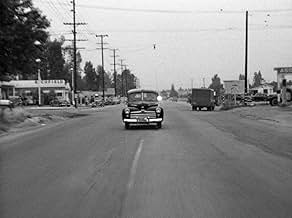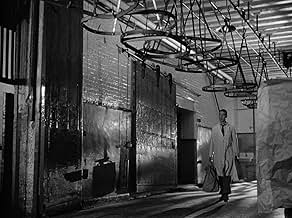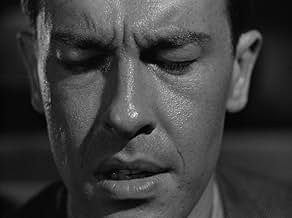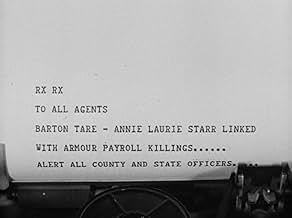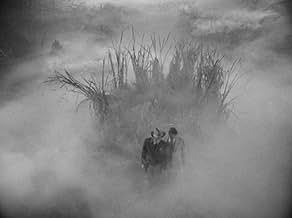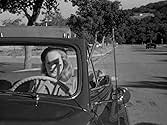NOTE IMDb
7,6/10
16 k
MA NOTE
Ajouter une intrigue dans votre langueTwo disturbed young people release their fascination with guns through a crime spree.Two disturbed young people release their fascination with guns through a crime spree.Two disturbed young people release their fascination with guns through a crime spree.
- Réalisation
- Scénario
- Casting principal
- Récompenses
- 1 victoire au total
Russ Tamblyn
- Bart Tare (age 14)
- (as Rusty Tamblyn)
David Bair
- Dave Allister (child)
- (as Dave Bair)
Frances Irvin
- Danceland Singer
- (as Frances Irwin)
Avis à la une
Bart Tare (John Dall) had a fascination with guns from an early age, even getting sent to a reform school at the age of 14 for yet another gun related incident. Back home now as an adult, after a stint in the army, he falls for a sharp-shooting carnival girl called Annie Laurie Starr (Peggy Cummins) and promptly joins the act. But after a fall out with the boss, the pair hit the road and turn to a life of crime - with Annie particularly showing a thirst for gun-play.
No doubt inspired by real life outlaws Bonnie Parker and Clyde Barrow, "Deadly Is the Female" (AKA: Gun Crazy) is as good a "doomed lovers on the lam" picture that has ever been made. It may be a "B" movie in terms of production, but no doubt about it, this film is stylish, crafty and also very sexy. Directed by the unsung Joseph H. Lewis ("My Name Is Julia Ross/The Big Combo"), it's based on a story written by MacKinlay Kantor that was reworked by Millard Kaufman (AKA: the then blacklisted "Dalton Trumbo"), into one that links sex and violence whilst simultaneously casting an eye over gun worship and its place in the American way of life. Dall & Cummings looked on the surface an odd pairing, but under Lewis' direction they go together like gun and holster (ahem). He is well spoken, almost elegantly fragile with his musings, yet underneath there is still this twitchy gun fanatic. She is savvy, almost virginal in sexuality, but ultimately she's a wild cat who's practically un-tamable.
The work of Lewis here should not be understated, check out the quite sublime continuous one take bank robbery. While marvel throughout at his long takes, use of angles, deep focus and jerking camera movements - all of which dovetail with our protagonists as they go on their nihilistic journey. But perhaps his master-stoke was with his preparation tactics for his two leads?. Sending them out with permission to improvise, he fired them up with sexual pep talks, and the result, in spite of the inevitable "code" restrictions, is a near masterpiece, a true genre highlight, and a film that continues to influence as much as it still entertains. 9/10
No doubt inspired by real life outlaws Bonnie Parker and Clyde Barrow, "Deadly Is the Female" (AKA: Gun Crazy) is as good a "doomed lovers on the lam" picture that has ever been made. It may be a "B" movie in terms of production, but no doubt about it, this film is stylish, crafty and also very sexy. Directed by the unsung Joseph H. Lewis ("My Name Is Julia Ross/The Big Combo"), it's based on a story written by MacKinlay Kantor that was reworked by Millard Kaufman (AKA: the then blacklisted "Dalton Trumbo"), into one that links sex and violence whilst simultaneously casting an eye over gun worship and its place in the American way of life. Dall & Cummings looked on the surface an odd pairing, but under Lewis' direction they go together like gun and holster (ahem). He is well spoken, almost elegantly fragile with his musings, yet underneath there is still this twitchy gun fanatic. She is savvy, almost virginal in sexuality, but ultimately she's a wild cat who's practically un-tamable.
The work of Lewis here should not be understated, check out the quite sublime continuous one take bank robbery. While marvel throughout at his long takes, use of angles, deep focus and jerking camera movements - all of which dovetail with our protagonists as they go on their nihilistic journey. But perhaps his master-stoke was with his preparation tactics for his two leads?. Sending them out with permission to improvise, he fired them up with sexual pep talks, and the result, in spite of the inevitable "code" restrictions, is a near masterpiece, a true genre highlight, and a film that continues to influence as much as it still entertains. 9/10
Gun Crazy (1950)
The clumsy original title, Deadly is the Female, is surely accurate. Boy was Peggy Cummins perfect in this role, and it's odd she did little else with her career. She's no searing dame as in other noirs, but she's a kind of regular, cute girl who attracts not men, but one particular man, played by John Dall. Dall is a perfect victim. He plays the innocent ordinary American guy perfectly, better than even a James Stewart because he has no charisma, no ability to inspire those around him.
So Annie and Bart form a pair of misfits who fit together. And they both love guns, and are really really good with them.
The plot is pretty straight forward from here, but it's fast, and photographed with more vigor than most better films. The dialog pushes the artifice of noir-speak a bit hard, but I swallow it whole and love it as style. And besides, these are two unsophisticated people who might just talk a little corny and dramatic at times. And Annie is truly unpredictable, and her ups and downs are a thrill for us as much as a worry for poor Bart.
Yes, a femme fatale and a noir hero, isolated and doomed. And some riveting long take photography including the now legendary camera view from the back seat of a car, on and on, and on, showing them driving, getting out, waiting while they rob a bank, swerving out a little to look out the window, pulling back, and following them on their escape. It's about as good as B-movie camera-work innovation gets. Cinematographer Russell Harlan was an A-movie quality guy from the studios, later to do "Witness for the Prosecution" and "To Kill a Mockingbird." The angles, the close-ups on their sweaty faces, the moving camera. Check it out.
This is a great movie, in all. Legendary for many reasons. It has flaws if you want to see them that way. Or it has all the raw energy of a scrappy fighter who is determined to win, and does.
The clumsy original title, Deadly is the Female, is surely accurate. Boy was Peggy Cummins perfect in this role, and it's odd she did little else with her career. She's no searing dame as in other noirs, but she's a kind of regular, cute girl who attracts not men, but one particular man, played by John Dall. Dall is a perfect victim. He plays the innocent ordinary American guy perfectly, better than even a James Stewart because he has no charisma, no ability to inspire those around him.
So Annie and Bart form a pair of misfits who fit together. And they both love guns, and are really really good with them.
The plot is pretty straight forward from here, but it's fast, and photographed with more vigor than most better films. The dialog pushes the artifice of noir-speak a bit hard, but I swallow it whole and love it as style. And besides, these are two unsophisticated people who might just talk a little corny and dramatic at times. And Annie is truly unpredictable, and her ups and downs are a thrill for us as much as a worry for poor Bart.
Yes, a femme fatale and a noir hero, isolated and doomed. And some riveting long take photography including the now legendary camera view from the back seat of a car, on and on, and on, showing them driving, getting out, waiting while they rob a bank, swerving out a little to look out the window, pulling back, and following them on their escape. It's about as good as B-movie camera-work innovation gets. Cinematographer Russell Harlan was an A-movie quality guy from the studios, later to do "Witness for the Prosecution" and "To Kill a Mockingbird." The angles, the close-ups on their sweaty faces, the moving camera. Check it out.
This is a great movie, in all. Legendary for many reasons. It has flaws if you want to see them that way. Or it has all the raw energy of a scrappy fighter who is determined to win, and does.
Peggy Cummins is the epitome of the bad dame.....in a word, terrific. The casting of this British actress was probably chancy for director Lewis but he hit paydirt. She comes across as a woman who wants it all and doesn't care how she gets it. Besides, she like to kill and wants to do "Just one more job." The choice of John Dall for the male lead was even more chancy. Dall, a stage actor, certainly wasn't very masculine and his acting revealed his stage background. But, again, Lewis hit the jackpot since it made the control that Cummins had over him even more believable.
The story has already been discussed on these boards so I won't repeat it except to say that it moves along at a rapid pace and keeps you enthralled from the beginning (well, not quite. Forget the sappy prologue and get right to the story.) A lot has been said about the one shot (from the back seat of the car) bank robbery but it is dynamite. It is said that Dall and Cummins' dialogue is improvised and that when you hear someone shout" The bank has been robbed", it is an actual pedestrian who did not know that a movie was being made. Now that's realism.
This little B thriller is as good as it gets and belongs right up there with "Detour", the gem of low-budget films. Enjoy!!!!!!!!!
The story has already been discussed on these boards so I won't repeat it except to say that it moves along at a rapid pace and keeps you enthralled from the beginning (well, not quite. Forget the sappy prologue and get right to the story.) A lot has been said about the one shot (from the back seat of the car) bank robbery but it is dynamite. It is said that Dall and Cummins' dialogue is improvised and that when you hear someone shout" The bank has been robbed", it is an actual pedestrian who did not know that a movie was being made. Now that's realism.
This little B thriller is as good as it gets and belongs right up there with "Detour", the gem of low-budget films. Enjoy!!!!!!!!!
At the time, such an idea of having the heroes being the criminals was un-heard of, but Joseph H. Lewis's film deservedly has its claim of being the little B-movie that could (forgive the mechanical analogy) by inspiring the French new-wave and other films like Bonnie & Clyde. The idea of having a tragic love story pitted in the middle of noir facade was also seen in the equally powerful low-budget They Live by Night. But while Nicholas Ray's film is more impressive on its emotional stakes, Gun Crazy rakes up points for some of its technical achievements. The style implemented by Lewis and DP Russel Harlan (also responsible for the great photography in Red River) adds excitement to the more suspenseful, even violent scenes, and adds some sentiment to the softer ones involving the couple. And I love the scenes where young Bart can't seem to put away his fascination with guns.
Bart (John Dall) starts off as a boy, and in some of these early scenes (some of the best in the film), we see how he is changed by an unfortunate act, and then the story skips ahead suddenly. Now Bart is an adult, out of the army, and gets re-introduced to guns once he meets his soon-to-be love and partner in crime, Annie, played by Peggy Cummins. From there, after getting married and needing (or rather wanting) money, they start robbing banks across country, but soon to meet their demise. But more than anything, the film's focus isn't one where 'crime doesn't pay' or some kind of typical, of-the-period nonsense. Like the Asphalt Jungle, we're given these conflicted, emotional beings who may meet their own ends with each other before the law. And in the film-noir tradition, it's the woman here who will act as a main catalyst for the end of them. It's psychological side of danger, pathological lies, and the pattern of a downward spiral in having to commit violent acts (even un-intentionally), becomes what really pulls in the viewer into the picture, aside from the more loose, on-location 'real' style and interesting camera-work.
Under more 'B-movie' conditions, Lewis sneaks in plenty of chances to look past some of the more cardboard cut-out forms the characters could have been. The acting by the leads is also very good, the script mostly by Dalton Trumbo is one of his best, and both understand how one reflects the other. Cummins is perfect in her part, even if Dall isn't quite as much a stand-out (though, of course, he's the sap to her more wicked side). Also out of the script comes cool lines like the one listed in the summary. It's a notch above many other B-noirs of the period, and should be seen by most serious fans of the 'mood' that came in noir films. A bit cynical, fatalistic to be sure, but it's smart too.
Bart (John Dall) starts off as a boy, and in some of these early scenes (some of the best in the film), we see how he is changed by an unfortunate act, and then the story skips ahead suddenly. Now Bart is an adult, out of the army, and gets re-introduced to guns once he meets his soon-to-be love and partner in crime, Annie, played by Peggy Cummins. From there, after getting married and needing (or rather wanting) money, they start robbing banks across country, but soon to meet their demise. But more than anything, the film's focus isn't one where 'crime doesn't pay' or some kind of typical, of-the-period nonsense. Like the Asphalt Jungle, we're given these conflicted, emotional beings who may meet their own ends with each other before the law. And in the film-noir tradition, it's the woman here who will act as a main catalyst for the end of them. It's psychological side of danger, pathological lies, and the pattern of a downward spiral in having to commit violent acts (even un-intentionally), becomes what really pulls in the viewer into the picture, aside from the more loose, on-location 'real' style and interesting camera-work.
Under more 'B-movie' conditions, Lewis sneaks in plenty of chances to look past some of the more cardboard cut-out forms the characters could have been. The acting by the leads is also very good, the script mostly by Dalton Trumbo is one of his best, and both understand how one reflects the other. Cummins is perfect in her part, even if Dall isn't quite as much a stand-out (though, of course, he's the sap to her more wicked side). Also out of the script comes cool lines like the one listed in the summary. It's a notch above many other B-noirs of the period, and should be seen by most serious fans of the 'mood' that came in noir films. A bit cynical, fatalistic to be sure, but it's smart too.
The original title of "Gun Crazy" was "Deadly Is the Female," and they ain't kidding. If you thought Faye Dunaway's Bonnie Parker was the more ruthless member of the crime duo that gave Arthur Penn's 1967 film its name, wait till you get a load of Peggy Cummins's Annie in this little known cheapie from 1949. I wouldn't want to get on this woman's bad side; she can shoot cigarettes out of people's mouths, for God's sake.
"Gun Crazy" is such an obvious influence on Penn's "Bonnie and Clyde" that I can't believe the later film doesn't credit it directly. Though the 1949 film is based on a short story that appeared in the "Saturday Evening Post" and the 1967 film worked with an original screenplay, both films could have been adapted from the same source. They portray the Annie/Bonnie character as bored and restless, turned on by the thought of crime and by a manly man who can really use his "gun." The Bart/Clyde character is tickled by the idea of being a virile stud in the eyes of his lover, but is ultimately too sensitive for the life they choose. And both films do a good job of portraying the desperation that plagues both couples, the isolation and loneliness they create for themselves and can never break out of, and the ultimate futility of their actions, since the "law" is going to catch up with them sooner or later.
Peggy Cummins is really good in this. I don't know what else she's been in, but her baby-doll voice creates an effective contrast to her colder-than-ice attitude. She's crooning into her lover's ear one minute and itching to kill someone the next. And you have to dig those French-inspired fashions that would cause a sensation nearly 20 years later when Dunaway donned them again for Penn's film.
I thought John Dall was at first odd casting for the role of Bart. Annie is supposed to think of him as a man's man, and Dall, with his willowy physique and gentle mannerisms is far from that. But then when we realize that he's at heart really too gentle for the life he and Annie have chosen for themselves, his casting makes sense.
There are some small touches to this film that really add to its immediacy and realism. I loved the scenes of Annie and Bart driving to and from their heist jobs, shot from the back seat of the car as if we are a member of their gang. They have really funny and natural banter back and forth about where to park, etc. which I have to believe was improvised to some extent. The ending of the film, a face off in a creepy swamp, is eerie, and there's a small twist in the last seconds of the film that might be easy to miss but may give you some things to think about if you catch it.
It's interesting, and rather depressing, that one of the main themes of this film is the obsession with guns and violence that pervaded the country nearly 60 years ago, and here we are a handful of wars later, still dragging around the same old obsessions. Michael Moore's recent documentary "Bowling for Columbine" could have just as easily been called "Gun Crazy," if that title weren't already taken by this forgotten little blast of a movie.
Grade: A-
"Gun Crazy" is such an obvious influence on Penn's "Bonnie and Clyde" that I can't believe the later film doesn't credit it directly. Though the 1949 film is based on a short story that appeared in the "Saturday Evening Post" and the 1967 film worked with an original screenplay, both films could have been adapted from the same source. They portray the Annie/Bonnie character as bored and restless, turned on by the thought of crime and by a manly man who can really use his "gun." The Bart/Clyde character is tickled by the idea of being a virile stud in the eyes of his lover, but is ultimately too sensitive for the life they choose. And both films do a good job of portraying the desperation that plagues both couples, the isolation and loneliness they create for themselves and can never break out of, and the ultimate futility of their actions, since the "law" is going to catch up with them sooner or later.
Peggy Cummins is really good in this. I don't know what else she's been in, but her baby-doll voice creates an effective contrast to her colder-than-ice attitude. She's crooning into her lover's ear one minute and itching to kill someone the next. And you have to dig those French-inspired fashions that would cause a sensation nearly 20 years later when Dunaway donned them again for Penn's film.
I thought John Dall was at first odd casting for the role of Bart. Annie is supposed to think of him as a man's man, and Dall, with his willowy physique and gentle mannerisms is far from that. But then when we realize that he's at heart really too gentle for the life he and Annie have chosen for themselves, his casting makes sense.
There are some small touches to this film that really add to its immediacy and realism. I loved the scenes of Annie and Bart driving to and from their heist jobs, shot from the back seat of the car as if we are a member of their gang. They have really funny and natural banter back and forth about where to park, etc. which I have to believe was improvised to some extent. The ending of the film, a face off in a creepy swamp, is eerie, and there's a small twist in the last seconds of the film that might be easy to miss but may give you some things to think about if you catch it.
It's interesting, and rather depressing, that one of the main themes of this film is the obsession with guns and violence that pervaded the country nearly 60 years ago, and here we are a handful of wars later, still dragging around the same old obsessions. Michael Moore's recent documentary "Bowling for Columbine" could have just as easily been called "Gun Crazy," if that title weren't already taken by this forgotten little blast of a movie.
Grade: A-
Le saviez-vous
- AnecdotesThe bank heist sequence was done entirely in one take, with no one other than the principal actors and people inside the bank aware that a movie was being filmed. When John Dall as Bart Tare says, "I hope we find a parking space," he really meant it, as there was no guarantee that there would be one. In addition, at the end of the sequence someone in the background screams that there's been a bank robbery - this was a bystander who saw the filming and assumed the worst.
- GaffesWhile trying (unsuccessfully) to escape capture in the mountains, Annie maintains possession of her purse, which she drops in the stream they're stumbling through. Immediately thereafter, she has it back.
- ConnexionsEdited into Chasse au gang (1953)
Meilleurs choix
Connectez-vous pour évaluer et suivre la liste de favoris afin de recevoir des recommandations personnalisées
- How long is Gun Crazy?Alimenté par Alexa
Détails
- Date de sortie
- Pays d’origine
- Sites officiels
- Langue
- Aussi connu sous le nom de
- Le démon des armes
- Lieux de tournage
- 2300 E Olympic Blvd, Los Angeles, Californie, États-Unis(Armour meatpacking plant)
- Sociétés de production
- Voir plus de crédits d'entreprise sur IMDbPro
Box-office
- Budget
- 400 000 $US (estimé)
- Montant brut mondial
- 17 322 $US
- Durée1 heure 27 minutes
- Couleur
- Rapport de forme
- 1.37 : 1
Contribuer à cette page
Suggérer une modification ou ajouter du contenu manquant

Lacune principale
By what name was Gun Crazy: Le démon des armes (1950) officially released in India in English?
Répondre



